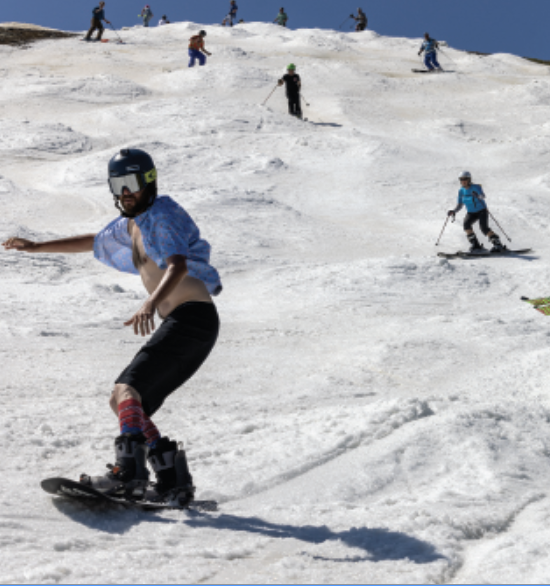New snowmaking technology and a passionate team helped make it possible
By Brooke Geery
Most people don’t associate skiing and snowboarding with the month of June, but at Killington Resort, it’s always the goal. That being said, it’s no easy feat. Ask anyone who showed up on June 4 last year and they’re sure to tell you it was an incredible experience complete with smiles and tie-dye t-shirts. They’ll probably also mention rappeling down the Superstar headwall and traversing large strips of mud to make it to the bottom.
This year, things were different. With temperatures in the 80s at the end of May, many at the resort didn’t expect to make it through Memorial Day weekend. But when June 1 hit, a reasonably thick white strip of snow covered Superstar from top to bottom, with only a short walk between the snow and the lift at the base. The top of the lift was connected, and the headwall was skiable all day without hitting rocks.
How did they pull it off? It took a little help from Mother Nature, a team of people working long hours, and a bit of new technology.
Grooming manager David Wright, a graduate of the KSRM program at Green Mountain College (now Resort Hospitality Management at Vermont State University) and Beast team member since 2005, said improved snow farming was possible thanks to the new Leica system from Prinoth. This technology took several seasons to be installed at Killington and was used for the first time during winter 2022/23. It comes from the construction world, essentially using the GPS location and precise elevation of the cat to calculate the depth of the snow at any given time.
Wright explained: “It’s not radar!” he laughed. “It uses a LIDAR scan of the mountain, which was a multi-year process. We flew the mountain and got our terrain model of what’s actually there, elevation and trail edges. The second part was installing the GPS rovers and cellular devices connected to the computer in the machine, which talk to a base station outside of my office and make the calculation of the depth of the snow under the cat. Having the terrain model, we know the elevation of the terrain in every given spot. As the machine drives over the snow, it calculates that difference and the operator can see it in real time on the screen.”
Short version? “We were able to manage the snow better than in previous years,” Wright summarized.
Of course, keeping snow through May in Vermont requires a lot of snow to begin with. Efforts to build out Superstar began during an unseasonably warm November for the Heroic Killington Cup over Thanksgiving weekend. The snowmaking team managed to take things from grass to World-Cup-skiing-ready in a matter of days. That base layer held up to several melt downs and every time the temperatures dropped and capacity allowed, the guns blasted Superstar, as well as the rest of Killington and Pico Mountain. Not only did this make for some great “manmade pow days” in December-March, it built up over 30 feet of base on Superstar and kept the season alive long after most resorts had called it quits.
Wright explains how snowmaking and grooming work together.
“We are part of the Snow Surfaces Department, led by Dave Lacombe,” he said. “We have a daily snow plan call that we get with Mountain Ops, Marketing and Ski Patrol. A lot of those decisions about where to make snow are made based on grooming [and ski patrol] reporting back. In the past it was institutional knowledge, we would just use whatever operators were saying – this is weak, that’s strong, we need to make snow here, run these guns, run those guns. Snowmaking would go and factor that into their plan. A lot of times snowmaking will reach back out to us and say, hey, can those guns go off? And now with the software we can run over a trail and go like, yeah, we’re good. Kill it.”
During the peak of the season, The Beast has 40 cat operators working in two shifts with 26 total snowcats to provide excellent skiing and riding daily. Once May hits, the workload and numbers drop significantly — the grooming team consists of Wright and 2-3 operators. The Snow Plan calls get shorter, but there are still decisions to be made on the best plan of attack.
“Our strategy depends on the weather,” Wright said. “How did it ski? Did it get bumped up? What is our end game? The more we disturb the snow, the theory is the faster it melts. Groom the whole trail? Groom half the trail? Groom none of the trail? It depends. We leave machines at the top and at the bottom. There’s been nights where we’ve not groomed anything but the load and unload and let it ski naturally and bumped wall to wall. And we adapt the plan as needed when we actually get out there.”
Diehard skiers enjoyed the fruits of their labor every weekend, and many didn’t want it to end. But as May wrapped up and the mercury topped 80, it was time to call it for the season. With June 1 falling on a Thursday, we debated holding out for one final Saturday send off, but ultimately the team decided on quality over longevity. History would prove we made the right call, as the snow had melted quickly and a rain cloud covered what was left on Saturday, June 3, eroding it down to mud.
“It was a challenging season but thanks to our great team and the aid of new technology, we were able to provide the best June skiing at Killington Resort,” Dave Lacombe said. “Quality is something we stake our reputation on, so it feels great to deliver.”




